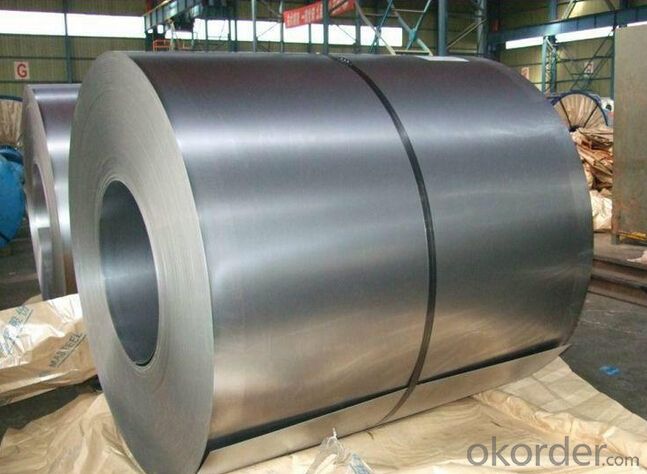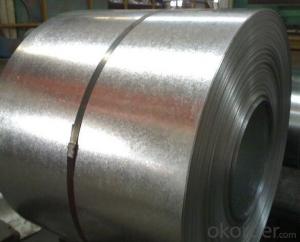Galvanized Steel Strip with Regular Spangle
- Loading Port:
- China main port
- Payment Terms:
- TT OR LC
- Min Order Qty:
- 25 m.t.
- Supply Capability:
- 20000 m.t./month
OKorder Service Pledge
OKorder Financial Service
You Might Also Like
1.Structure of Hot-Dip Galvanized Steel Strips Description:
Hot-dip galvanized steel coils are available with a pure zinc coating through the hot-dip galvanizing process. It offers the economy, strength and formability of steel combined with the corrosion resistance of zinc. The hot-dip process is the process by which steel gets coated in layers of zinc to protect against rust. It is especially useful for countless outdoor and industrial applications. Production of cold formed corrugated sheets and profiles for roofing, cladding, decking, tiles, sandwich walls, rainwater protective systems, air conditioning duct as well as electrical appliances and engineering.
2. Main Features of the Hot-Dip Galvanized Steel Strips:
• Excellent process capability
• Smooth and flat surface
• Workability, durability
• Excellent anticorrosive property
• High strength
• Good formability
• Good visual effect
3. Hot-Dip Galvanized Steel Strips Images

4. Hot-Dip Galvanized Steel Strips Specification
1) Capacity: about 15,000 tons per month for sheet product.
2) Standard: JIS G3302 1998, ASTM A653M/A924M 2004, all according to the customer's request
3) Thickness: 0.13mm-0.5mm
4) Width: 400mm-1000mm
5) Length: We can adjust the length according to your request
6) Zinc Coating Weight: 60g/m2-275g/m2
7) Raw Materials: Galvanized steel sheet and Pre-painted galvanized steel sheet
8) Spangle: Regular spangle, minimized spangle and zero spangle
9) Hardness: Full hard, normal
C | Si | Mn | Cr | Ni | P | S |
0.150 | 0.476 | 11.231 | 12.50 | 0.900 | 0.039 | 0.010
|
5.FAQ of Hot-Dip Galvanized Steel Strips
We have organized several common questions for our clients,may help you sincerely:
1. How to guarantee the quality of the products?
We have established the international advanced quality management system,every link from raw material to final product we have strict quality test;We resolutely put an end to unqualified products flowing into the market. At the same time, we will provide necessary follow-up service assurance.
2. How long can we receive the product after purchase?
Production period is 30 days. And we’d prefer you can give us more time to book vessel.
3. What’s the usage of galvanized steel strips?
Auto manufacture, Oil drum, Transformer's tank panel, Furniture etc.
- Q:How are steel coils different from steel sheets?
- Steel coils and steel sheets are both made from the same material, steel, but they differ in terms of shape and size. Steel coils are long, continuous rolls of steel that are typically wound up into a coil shape. They are generally used for industrial purposes and can be processed further to create various products like pipes, tubes, or automotive parts. On the other hand, steel sheets are flat pieces of steel that are available in various thicknesses. They are commonly used in construction, manufacturing, and fabrication processes where a flat surface is required, such as roofing, cladding, or panels.
- Q:Are steel coils used in construction?
- Yes, steel coils are commonly used in construction. They are used for various applications such as structural framing, roofing, walls, and other components in buildings and infrastructure projects. Steel coils provide strength, durability, and flexibility, making them a popular choice in construction.
- Q:How are steel coils processed for stamping or forming?
- Steel coils are typically processed for stamping or forming by first uncoiling them and then flattening or leveling them to remove any curvatures or distortions. After that, the coils are fed into a stamping or forming machine, where they undergo different processes such as cutting, bending, or shaping to achieve the desired final product.
- Q:What are the common defects in steel coil surface finishes?
- Common defects in steel coil surface finishes can include scratches, pits, rust, oil stains, and uneven coating. Scratches can occur during handling and transportation, and they can affect the overall appearance and performance of the steel coil. Pits are small depressions on the surface caused by a variety of factors such as impurities in the steel or improper processing. Rust can form when the steel coil is exposed to moisture or corrosive environments, and it can weaken the structural integrity of the material. Oil stains can occur if the coil is not properly cleaned before or after processing, leaving unsightly marks on the surface. Uneven coating can happen during the application of protective coatings or paints, resulting in areas with different levels of protection and aesthetics. It is important to address these defects to ensure the quality and durability of the steel coil for its intended applications.
- Q:What is the material of steel coil 08F and what brand can be used instead?
- 20 steel used for various mechanical parts is not subjected to great stress and toughness, such as rod, sleeve, screw, lifting hook; also can be used for manufacturing in 60 pressure and 450 DEG C using non corrosive medium pipes, pipe; can also be used for carbon and cyanide carburized core strength is not the chain, such as bushings, roller, shaft and gear, sprocket and other important.
- Q:What is the maximum load capacity for steel coil storage racks?
- The maximum load capacity for steel coil storage racks can vary depending on the specific design and specifications of the rack. However, typically, steel coil storage racks can support loads ranging from a few thousand pounds to tens of thousands of pounds per level. It is important to refer to the manufacturer's guidelines and consult with structural engineers to determine the exact load capacity for a particular rack.
- Q:I was just thinking, is their a way to make steel qualities inherent in concrete, therefore eliminating the need for re bar?
- Mixing hot steel with liquid concrete would be very hazardous to your health. Steal in a molten state would flash the water in the concrete mix into steam and the steam would blow concrete and steel out of your mold. This would be about like being shot with a shotgun. This occurred in a steel mill near me some years ago on a rainy day when some steel splashed from a ladle and landed on a puddle of water, part of the siding was blown off the building and one worker sent to the hospital.
- Q:What is the accuracy of steel tape inspection?
- In addition, the project is through the detection of steel tape, steel tape each batch have the error him different, so do projects each into a batch of steel tape has to go through the inspection department, let this batch of steel tape has reached the same error range. All the measuring tools in this project are unified into these steel tape measures, so that the measurement error is guaranteed
- Q:What are the common coil grades available for steel coils?
- There are several common coil grades available for steel coils, each with its own specific properties and applications. Some of the most commonly used coil grades include: 1. Hot Rolled Coils (HRC): This grade is produced by heating a slab of steel above its recrystallization temperature and then rolling it into a coil. HRC coils are known for their excellent weldability and formability, making them suitable for a wide range of applications such as construction, automotive manufacturing, and general engineering. 2. Cold Rolled Coils (CRC): These coils are produced by further processing hot rolled coils through cold reduction, which involves passing the steel through a series of rollers at room temperature. CRC coils have superior surface finish and dimensional accuracy, making them ideal for applications that require a smooth and uniform appearance, such as automotive body panels, appliances, and electrical equipment. 3. Galvanized Coils (GI): Galvanized steel coils are created by coating regular carbon steel coils with a layer of zinc through a hot-dip galvanizing process. This provides excellent corrosion resistance, making GI coils suitable for outdoor applications like roofing, fencing, and structural components. 4. Stainless Steel Coils: Stainless steel coils are manufactured from a variety of grades, with the most common being austenitic (such as 304 and 316) and ferritic (such as 430). Stainless steel coils offer excellent corrosion resistance, high temperature resistance, and aesthetic appeal, making them widely used in industries like food processing, chemical processing, and architecture. 5. Electro-galvanized Coils (EG): Electro-galvanized coils are similar to GI coils, but the zinc coating is applied using an electrolytic process instead of hot-dipping. EG coils have a thinner and smoother zinc layer, making them suitable for applications that require a brighter and more aesthetic appearance, such as automotive parts, appliances, and decorative items. These are just a few of the common coil grades available for steel coils. The selection of the appropriate grade depends on factors such as the intended application, required mechanical properties, and desired aesthetics. It is important to consult with steel suppliers or industry experts to determine the most suitable coil grade for a specific application.
- Q:How are steel coils used in the manufacturing of railway tracks?
- Steel coils are used in the manufacturing of railway tracks to produce high-quality and durable rails. These coils are unwound and undergo a series of processes such as rolling, heating, and shaping to form long, straight sections of rail tracks. The steel coils provide the necessary strength and flexibility required to withstand the heavy loads and constant stress of trains running on the tracks.
1. Manufacturer Overview |
|
|---|---|
| Location | |
| Year Established | |
| Annual Output Value | |
| Main Markets | |
| Company Certifications | |
2. Manufacturer Certificates |
|
|---|---|
| a) Certification Name | |
| Range | |
| Reference | |
| Validity Period | |
3. Manufacturer Capability |
|
|---|---|
| a)Trade Capacity | |
| Nearest Port | |
| Export Percentage | |
| No.of Employees in Trade Department | |
| Language Spoken: | |
| b)Factory Information | |
| Factory Size: | |
| No. of Production Lines | |
| Contract Manufacturing | |
| Product Price Range | |
Send your message to us
Galvanized Steel Strip with Regular Spangle
- Loading Port:
- China main port
- Payment Terms:
- TT OR LC
- Min Order Qty:
- 25 m.t.
- Supply Capability:
- 20000 m.t./month
OKorder Service Pledge
OKorder Financial Service
Similar products
New products
Hot products
Related keywords




























